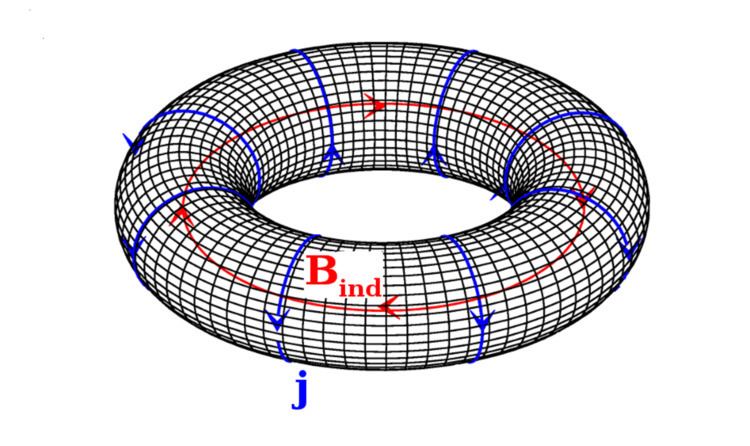 | ||
A toroidal moment is an independent term in the multipole expansion of electromagnetic fields besides magnetic and electric multipoles. In the electrostatic multipole expansion, all charge and current distributions can be expanded into a complete set of electric and magnetic multipole coefficients. However, additional terms arise in an electrodynamic multipole expansion. The coefficients of these terms are given by the toroidal multipole moments as well as time derivatives of the electric and magnetic multipole moments. While electric dipoles can be understood as separated charges and magnetic dipoles as circular currents, axial (or electric) toroidal dipoles describes toroidal charge arrangements whereas polar (or magnetic) toroidal dipole (also called anapole) correspond to the field of a solenoid bent into a torus.
Contents
- Classical toroidal dipole moment
- Quantum toroidal dipole moment
- Symmetry properties of dipole moments
- Magnetic toroidal moments in condensed matter physics
- Magnetic toroidal moment and its relation to the magnetoelectric effect
- Ferrotoroidicity in condensed matter physics
- Anapole dark matter
- Literature
- References
Classical toroidal dipole moment
A complicated expression allows the current density J to be written as a sum of electric, magnetic, and toroidal moments using Cartesian or spherical differential operators. The lowest order toroidal term is the toroidal dipole. Its magnitude along direction i is given by
Since this term arises only in an expansion of the current density to second order, it generally vanishes in a long-wavelength approximation.
Quantum toroidal dipole moment
In 1957, Yakov Zel'dovich found that because the weak interaction violates parity symmetry, a spin-1/2 Dirac particle must have a toroidal dipole moment, also known as an anapole moment, in addition to the usual electric and magnetic dipoles. The interaction of this term is most easily understood in the non-relativistic limit, where the Hamiltonian is
where d, μ, and a are the electric, magnetic, and anapole moments, respectively, and σ is the vector of Pauli matrices.
The nuclear toroidal moment of cesium had been measured in 1997 by Wood et al.
Symmetry properties of dipole moments
All dipole moments are vectors which can be distinguished by their differing symmetries under spatial inversion (P: r ↦ −r) and time reversal (T: t ↦ −t). Either the dipole moment stays invariant under the symmetry transformation ("+1") or it changes its direction ("−1"):
Magnetic toroidal moments in condensed matter physics
In condensed matter magnetic toroidal order can be induced by different mechanisms:
Magnetic toroidal moment and its relation to the magnetoelectric effect
The presence of a magnetic toroidic dipole moment T in condensed matter is due to the presence of a magnetoelectric effect: Application of a magnetic field H in the plane of a toroidal solenoid leads via the Lorentz force to an accumulation of current loops and thus to an electric polarization perpendicular to both T and H. The resulting polarization has the form Pi = εijkTjHk (with ε being the Levi-Civita symbol). The resulting magnetoelectric tensor describing the cross-correlated response is thus antisymmetric.
Ferrotoroidicity in condensed matter physics
A phase transition to spontaneous long-range order of microscopic magnetic toroidal moments has been termed "ferrotoroidicity". It is expected to fill the symmetry schemes of primary ferroics (phase transitions with spontaneous point symmetry breaking) with a space-odd, time-odd macroscopic order parameter. A ferrotoroidic material would exhibit domains which could be switched by an appropriate field, e.g. a magnetic field curl.
The existence of ferrotoroidicity is still under debate and clear-cut evidence has not been presented yet—mostly due to the difficulty to distinguish ferrotoroidicity from antiferromagnetic order, as both have no net magnetization and the order parameter symmetry is the same.
Anapole dark matter
All CPT self-conjugate particles, in particular the Majorana fermion, are forbidden from having any multipole moments other than toroidal moments. At tree level (?), an anapole-only particle interacts only with external currents, not with free-space electromagnetic fields, and the interaction cross-section diminishes as the particle velocity slows. For this reason, heavy Majorana fermions have been suggested as plausible candidates for cold dark matter.
